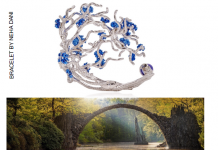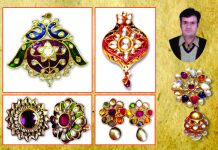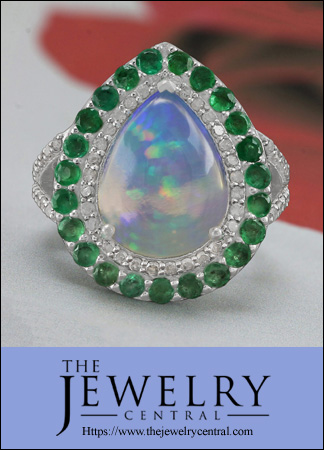The magic of colours
 Colour appeals to our feelings directly. It makes us happy and cheerful, livens us up or calms us down, and has a magical or liberating effect. And where is colour more lastingly and more beautifully captured than in a gemstone? In the fascinating world of precious stones, emeralds glow in the fieriest green imaginable. Aquamarines sparkle in a whole range of blues – from the light blue of the sky to the deep blue of the sea. And the charming pink of morganite puts a spell on women the whole world over. Yet how many people are aware of the fact that these gems, different as they are, belong to a single family? Aquamarine, emerald and morganite are all beryls – just like golden beryl, yellowish-green heliodor, colourless goshenite and the rare red beryl. Whether blue, green, yellow, colourless or pink, their chemical and physical properties essentially correspond; it is only in their colours that they differ from one another so much.
Colour appeals to our feelings directly. It makes us happy and cheerful, livens us up or calms us down, and has a magical or liberating effect. And where is colour more lastingly and more beautifully captured than in a gemstone? In the fascinating world of precious stones, emeralds glow in the fieriest green imaginable. Aquamarines sparkle in a whole range of blues – from the light blue of the sky to the deep blue of the sea. And the charming pink of morganite puts a spell on women the whole world over. Yet how many people are aware of the fact that these gems, different as they are, belong to a single family? Aquamarine, emerald and morganite are all beryls – just like golden beryl, yellowish-green heliodor, colourless goshenite and the rare red beryl. Whether blue, green, yellow, colourless or pink, their chemical and physical properties essentially correspond; it is only in their colours that they differ from one another so much.
 So where does this diversity come from? It is an exciting and very ancient story, which began millions of years ago when the appropriate pressure and temperature conditions formed precious crystals in the centre of the Earth. Beryls are beryllium-aluminium-silicates. As pure beryl, they are colourless, but they are able on account of their structure to store various foreign substances, and it is these which give rise to the various colours, turning a plain, colourless gemstone into a green, yellow, pink or blue treasure.
So where does this diversity come from? It is an exciting and very ancient story, which began millions of years ago when the appropriate pressure and temperature conditions formed precious crystals in the centre of the Earth. Beryls are beryllium-aluminium-silicates. As pure beryl, they are colourless, but they are able on account of their structure to store various foreign substances, and it is these which give rise to the various colours, turning a plain, colourless gemstone into a green, yellow, pink or blue treasure.
Iron colours beryl in the most beautiful sea-blue hues, turning it into aquamarine, one of our best known and most popular gems. This gem not only shines in all the colours of water – fine blue shades which can complement almost any skin or eye colour – ; a slight green shimmer is also one of its typical features. Aquamarine is the favourite stone of many a creative designer and distinguishes itself by a whole series of good qualities: even distribution of the colour, inclusions which hardly spoil the effect at all, good hardness and a wonderful shine.
 The emerald is closely related to the aquamarine. This most valuable of all the beryls is given the most beautiful, intense and glowing green imaginable, namely emerald green, by chrome and/or vanadium. Small crystal inclusions, cracks or fissures are not merely tolerated in this precious gemstone; they are actually regarded as features of its identity. Connoisseurs refer to them affectionately as the jardin (garden) of the emerald.
The emerald is closely related to the aquamarine. This most valuable of all the beryls is given the most beautiful, intense and glowing green imaginable, namely emerald green, by chrome and/or vanadium. Small crystal inclusions, cracks or fissures are not merely tolerated in this precious gemstone; they are actually regarded as features of its identity. Connoisseurs refer to them affectionately as the jardin (garden) of the emerald.
Beryl behaves quite differently when there is manganese involved. This element gives it a special feminine pink, turning it into morganite, without doubt the next best known representative of the beryl group after the classics, emerald and aquamarine. Formerly, it was known rather plainly as ‘pink beryl’. It has only been called morganite since the year 1911, having been so named in honour of the New York finance expert and gemstone collector John Pierpont Morgan. This gemstone loves generosity, since it is only from a certain size upwards that the beauty of its colour, mostly ranging from a tender pink to a pale violet, is shown to its full advantage.
Small traces of iron, and a natural aura which emanates from minerals containing uranium, are sufficient to give a colourless beryl a more or less intense yellow tone – the typical colour of the golden beryl. This gem has practically the same good qualities as its light blue cousin, the aquamarine. Indeed, as a rule it is found in the same kind of deposit. Golden beryl holds a fascination with its fine spectrum of yellow hues, from a weak lemon yellow to a warm golden colour. Unlike the emerald, however, it seldom has inclusions.
Iron and uranium together are also responsible for the fresh, stimulating greenish yellow of another beryl variety, the heliodor. The name goes with the colour very well, being derived from the Greek helios (sun) and doron (gift). So heliodor is a ‘gift from the sun’ to Man.
 Now and again, beryl is found which lacks these colouring substances. In such cases it simply remains a ‘mere’ colourless beryl. In the trade, it is more often referred to as goshenite after the place where it was originally found, Goshen, in Massachusetts. Colourless beryl is rare, and has little significance as a gemstone. It does, however, have some historical importance, having been the forerunner of today’s spectacles. Even in ancient times, beryl was used to make glasses.
Now and again, beryl is found which lacks these colouring substances. In such cases it simply remains a ‘mere’ colourless beryl. In the trade, it is more often referred to as goshenite after the place where it was originally found, Goshen, in Massachusetts. Colourless beryl is rare, and has little significance as a gemstone. It does, however, have some historical importance, having been the forerunner of today’s spectacles. Even in ancient times, beryl was used to make glasses.
Originally, the name ‘beryl’ came from India. It was derived from the Sanskrit word ‘veruliyam’, an old term for the gemstone chrysoberyl, from which the Greek word ‘beryllos’ later developed.
Beryls are popular gems, not only on account of their magnificent colours. Their appeal also lies in their high brilliance and qualities such as their hardness (7.5 to 8), which makes them admirably well suited for use in jewellery. The typical hexagonal beryl crystals with their often vertically striated surfaces are mainly found in the gemstone deposits of South America and those of Central and West Africa. However, they also occur on Madagascar, in Russia and the Ukraine, and in the USA. The skilled hands of gemstone cutters turn them into a multitude of many-faceted shapes. In particular, beryls are well suited to rectangular or square step cuts, since it takes a clear design to bring out the transparent beauty of this colourful gemstone family to the full.

















